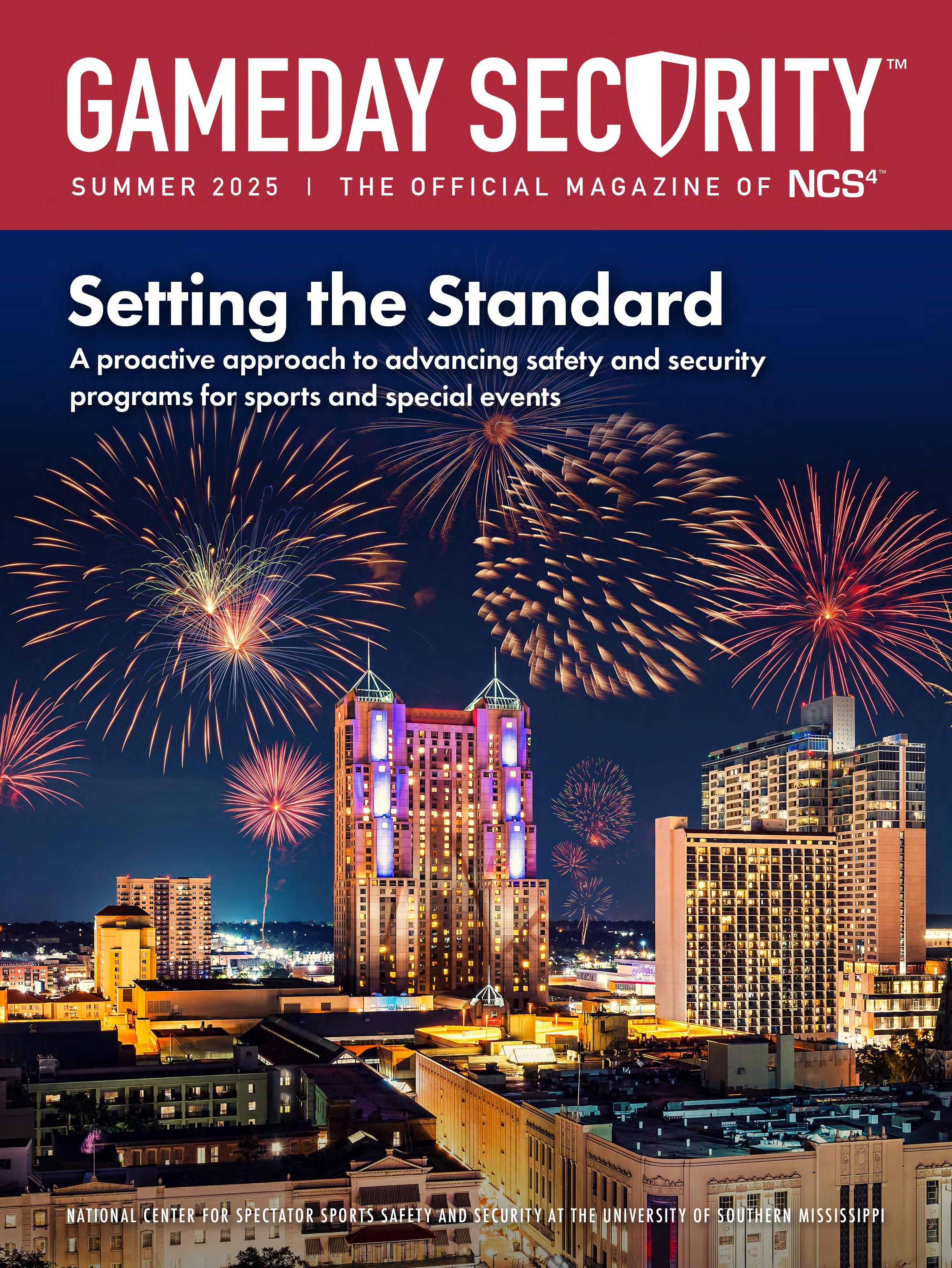




ESTABLISHED IN 2006, the National Center for Spectator Sports Safety and Security (NCS4) is the nation’s only academic center devoted to the study and practice of spectator sports safety and security. The NCS4’s strategic priorities are guided by a National Advisory Board and industry Advisory Committees.
The NCS4 collaborates with professional associations, government agencies, academic entities, and the private sector to provide training, resources, and networking opportunities.
We support the sports and entertainment industries through innovative research, training, and outreach programs. Our mission is realized by working closely with a diverse group of organizations and subject matter experts to better understand the threat environment, identify vulnerabilities, communicate risk-mitigation techniques, and close capability gaps.
We will be a leading partner with government, private sector, and sports and entertainment organizations to create and deliver critical resources for enhancing safety and security.
The NCS4 is located in the Trent Lott National Center at The University of Southern Mississippi (USM), a top-tier (R1) Carnegie classified institution for its very high research activity. The Center is partially funded by grants from the Department of Homeland Security (DHS) and Federal Emergency Management Agency (FEMA).
A Note From the Executive Director, Dr. Stacey A. Hall
With new credentialing technology in place for gameday staff, media and others, the NFL has activated what one stadium official calls an ‘onion of security.’
As more people participate in legalized sports betting — and the stakes get higher — online harassment of athletes is escalating. Learn what you can do.
Applying for SAFETY Act designation and certification status requires a major commitment from venue operators, but the return on investment can be significant.
National Center for Spectator Sports Safety and Security 118 College Drive #5193 | Hattiesburg, MS 39406 | 601-266-6183 NCS4.USM.EDU
Dr. Stacey A. Hall
We are excited to present our summer edition of the Gameday Security Magazine. This issue addresses the online harassment of athletes as more people participate in legalized sports betting, discusses the potential return on investment for venue operators applying for DHS SAFETY Act designation and certification status, and highlights the success of a recently implemented biometric credentialing system at all NFL venues. I hope you enjoy the articles included in this edition.
The NCS4 mission is to support the sports and entertainment industries through training and education, research, and outreach programs. The NCS4 continues to be a significant resource in helping advance safety and security best practices, and I would like to share our impact and progress on some items since the fall, including:
• Over 55,000 people have been trained through the DHS/FEMA/TEEX training program since its inception. Eight courses are available, covering topics such as risk management, incident management, crisis communications, evacuation planning, crowd management, and staff training and development (released January 2025).
• The NCS4 eLearning suite consists of four courses, including frontline staff foundational skills, crowd management, venue staff training - security awareness, and the senior leader course in sports and entertainment security. Check out NCS4LEARN for more information.
• The Certified Sport Security Professional (CSSP) program continues to grow. The certification is for professionals currently serving in the sports security industry or those individuals planning career transitions to the sport and special event security industry. Check out the application process here.
• A new Tech Webinar titled ‘The DHS SAFETY Act and Its Broader Implications for Risk Management’ is now available. Webinars are available here
• A new Research Seminar Series on the security of professional sports facilities is now available. Seminars are available here
• The 2025 Spectator Sports Safety and Security Industry Research Report will be available in September 2025.
• A Handbook of Sport Security edited by Dr. Stacey Hall, NCS4 Executive Director, will be published in Fall 2025 by Routledge, a Taylor and Francis Group.
• The NCS4 staff and research affiliates presented at local, national, and international conferences and workshops. In addition, they have contributed to peer-reviewed journal articles and professional magazine publications.
• The NCS4, in collaboration with DHS/CISA, will publish a lightning safety guide for outdoor venues and events this summer.
• The 2025 Sport and Entertainment Technology Alliance members include 24/7 Software, Accredit Solutions, AirSight, Aluma, Axis Communications, BEST Crowd Management, Databuoy, Esri, inOrbit, NVIDIA, Raven Controls, Red Ball Drills, S2 Global, Titan HST, and Xtract One.
• The NCS4 hosted sold-out forums for the Marathon and Endurance Events community in December 2024 in Virginia Beach and the Intercollegiate Athletics community at Duke University in January 2025.
• The 16th Annual Conference and Exhibition will be held June 30-July 2 at the JW Marriott San Antonio Hill Country Resort and Spa. This year’s conference theme, Setting the Standard, focuses on defining and implementing the highest levels of safety and security for sports and special events. We look forward to welcoming over 500 attendees and 70 exhibitors, honoring leaders in the field at the awards luncheon, and awarding scholarships to young professionals through our program sponsored by Axis Communications.
The NCS4 team is grateful for our partnerships with professional associations, government agencies, solution providers, and academic entities. We also appreciate the support of our membership base. The National Advisory Board, Advisory Committees, Technology Alliance, and CSSP Commission continue to be instrumental in helping shape our strategic priorities to address the challenges and needs of our industry.
I hope you all have a fun and safe summer!
Best wishes,

Stacey A. Hall, Ph.D. NCS4 Executive Director and Professor of Sport Management
Dr. Stacey A. Hall
Executive Director and Professor of Sport Management
Lauren Cranford Director of Operations
Dr. Brandon Allen Director of Research and Associate Professor of Sport Management
Michael Broadus Curriculum Manager
Anthony Palazzolo Manager of Marketing and Business Development
Sara Priebe Event and Membership Manager
Jonathan Ruffin Instructional Design Specialist
Tymika Rushing Business Affairs Manager
Jonathan Stanford Training Manager
Roger Swartz Senior Training Manager
Natalie Williams Training Manager
Peyton Phillips Graduate Assistant
Brooklynn Pinegar Graduate Assistant
Nishit Thapa Web Developer
Lauren Villarreal Graduate Assistant
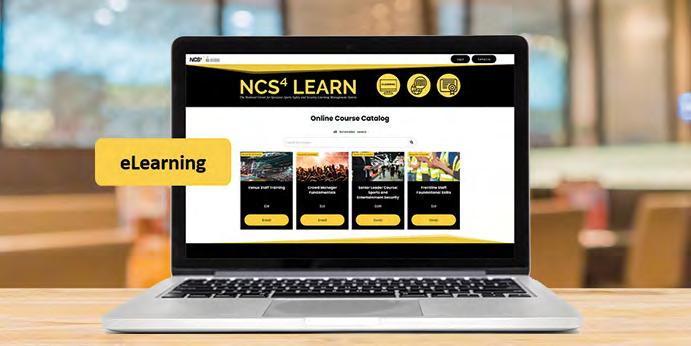
NCS4 LEARN provides eLearning professional development opportunities for all staff levels, including frontline staff, supervisory, and leadership. Organizations can enroll and monitor their teams in asynchronous and customizable learning experiences. The course catalog currently includes the following:
• Frontline Staff Foundational Skills – introduces frontline staff members to the skills necessary for providing guests with a safe and enjoyable experience.
• Venue Staff Training: Security Awareness – enhances safety and security awareness among venue and event staff, providing a foundational understanding of safety and security principles for your organization to build upon.
• Crowd Manager Fundamentals – provides a foundational understanding of safety and security principles for frontline venue and event staff with role-specific add-ons (i.e., guest services, parking management, concessions, ticket-takers).
• Senior Leader Course: Sports and Entertainment Security – covers security leadership fundamentals in business management, emergency management, planning considerations, legal and regulatory guidance, crowd management, and security procedures.
Please visit the website or contact us at NCS4Learn@usm.edu if you have any questions or would like to inquire about bulk registration.

Scan the QR code or visit our website to learn more. NCS4.USM.EDU/ELEARNING
CO-CHAIRS: RICHARD FENTON AND BILLY LANGENSTEIN; SECRETARY: GARY GARDNER
Virginia Brophy Achman VPrepared
Akmal Ali, J.D. Aluma & inOrbit
Matthew Bettenhausen, CPP, CSSP AEG Worldwide
Scott Breor Cybersecurity and Infrastructure Agency (CISA)
Jason DiJoseph Federal Bureau of Investigation (FBI)
Scott Dunn Axis Communications
Richard Fenton, CSSP Ilitch Holdings
Brian Finch Pillsbury Winthrop Shaw Pittman LLP
Gary Gardner TOTALeACCESS, Inc.
Steve Georgas, CPP, CSSP Levy
Mike Hartnett Ilitch Sports and Entertainment
Elliot Hopkins, CSSP National Federation of State High School Associations (NFHS)
Michael Hughes Federal Law Enforcement Officers Association (FLEOA)
G.B. Jones FIFA World Cup 2026 (FWC2026)
John Junell Live Nation Entertainment
Billy Langenstein, CSSP National Football League (NFL)
Jared Maples National Hockey League (NHL)
Jim Mercurio San Francisco 49ers and Levi’s Stadium
Joe Monroe, CSSP University of Kentucky
Larry Naifeh University of Oklahoma
Leon Newsome National Basketball Association (NBA)
Steve Olsen PGA Tour
Donald Paisant Texas Rangers Baseball Club
Linda Reid
Walt Disney World
Michael Rodriguez USTA and US Open Security
Russ Simons Venue Solutions Group
Jeff Stonebreaker, CSSP Major League Soccer (MLS)
David Thomas Major League Baseball (MLB)
Eddie Washington, CSSP University of Michigan
CO-CHAIRS: EUGENE BYRD JR. AND
Joshua Ball Kansas City Chiefs
Mariah Barber Pacers Sports and Entertainment
Troy Brown XFL
Eugene Byrd Jr. Major League Soccer (MLS)
Daneeque Chamberlain State Farm Stadium
Vernon Conaway Maryland Stadium Authority
Joe Coomer
Mercedes-Benz Stadium
Mario Coutinho Toronto Blue Jays Baseball Club
Chris Curran National Football League (NFL)
Andrea Evans ASM Global, Gila River Arena (NHL)
Rick Fenton Ilitch Holdings Inc.
Kevin Hackenbrack Philadelphia Phillies
Jasmine Harris Target Center – ASM Global
Mike Hartnett Detroit Red Wings / Detroit Tigers
J.P. Hayslip Philadelphia Eagles
Kevin Henry Pocono Raceway
Brian Herbert Golden State Warriors
Jim Hosfelt Dover Motor Speedway
Darren Johnson Detroit Lions / Ford Field
Annie Kosky Orlando Magic
Billy Langenstein National Football League (NFL)
Melanie Lee
Major League Baseball (MLB)
Meredith Ley Major League Soccer (MLS)
Toby McSwain LIV Golf
Todd Metro Miami Marlins
Angie Nix MetLife Stadium
Donald Paisant Texas Rangers Baseball Club
Russ Simons
Venue Solutions Group
Michelle Y. Spahn
St. Louis Cardinals
Bill Squires
New York Football Giants / MetLife Stadium
Brian Zumwalt
Dallas Cowboys
CO-CHAIRS: JAMEY KIRBY AND JOHN PEPPER
Nilo Ambriz Monster Energy Corporation
Earl Biggett Orange County Convention Center
Jason Caceres Amazon
Michael Diienno National Event Services
Bryan Frieders Redrock Entertainment
Steve Georgas Levy
Charles Gray Google
Mike Hartnett Ilitch Holdings Inc.
John Junell Live Nation Entertainment
Jeff Keas
Populous
Jamey Kirby
ASM Global
Scott Lavey DraftKings Inc.
Victor Mancebo Live Nation Entertainment
Gilbert Marroquin AEG Worldwide
Brian Murphy Navy Pier
Anders Noyes Honolulu Museum of Art
John Pepper
Major League Soccer (MLS)
Johnny Romero AEG Presents Festivals
James Seagle Gas South District
Tim Sjogren Kimley-Horn
Tim Smith C3 Presents
Travis Smith
Virginia Beach Police Department
Ed Warm Joe’s Concerts / Windy City Smokeout
Ben Williams
Houston First Corporation and Convention Center
Megan Williams
Barack Obama Presidential Library
CO-CHAIRS: JEFFREY STOLL AND BECCA WILUSZ
David Allison University of Texas
Ian Ballantyne Yale University
Randy Buhr NCAA
Andrew Burchfield i2G Systems
Brian Cordill
Kansas State University
Julie Cribbs Louisiana State University
Kory Dahlen
Southeastern Conference (SEC)
Matt Davidson University of Nebraska
Scott Dickson The Ohio State University
Matt Elliott University of Alabama
Evan Feinglass University of Connecticut
Mike Gregory University of Tennessee
Lee Harris University of California
Byron Hatch College Football Playoff
David Hensgen University of Texas, El Paso
Orville Jennings The University of Arizona
Keith Kopinski University of Notre Dame
Bryan G. Makinen
Eastern Kentucky University
Jason Meisner Colorado State University
Leigh Ann Moffett Southern Methodist University
Joe Monroe University of Kentucky
David Oliver Western Kentucky University
Hatcher Parnell University of Southern California
Korinth Patterson MAC Sports
Drew Pittman Baylor University
Christie Purks University of Georgia
Todd E. Sandstedt SecureSport
Nicholas Scull
Georgia Southern University
Jeffrey Stoll NCAA
Becca Wilusz, PhD Duke University Athletics
CO-CHAIRS: KYLE POORE AND DENA SCOTT
Ann Clifton
Governor Livingston High School
Brett Coulter Maryville City Schools
Randy Councell Cherry Creek Schools
Lamont Dodson Cleveland Metropolitan School District
Kathy Drenth East Jordan Public Schools
Wayne Folkes
Lamar County School District
Christopher Furlong Cranbrook Educational Community
Dale Hackbarth
St. Marks School of Texas
Jay Hackett, CSSP Milton Academy
Elliot Hopkins, CSSP National Federation of State High School Associations (NFHS)
Jim Inskeep Carmel High School
Larry Johnson Grand Rapids Public Schools
Karyn McCoy The Hockaday School
John Paton
Alberta Schools Athletic Association
Kyle Poore Lincoln Public Schools
Ben Rolens, CSSP
Katy Independent School District
Jack Sample Nettleton School District
Dena Scott Fort Bend Independent School District
Dr. Dustin Smith
Broken Arrow Public Schools
Danielle Stevens Lake Zurich School District
Gary Stevens Thornton Academy
Craig Straw
Texas City Independent School District
Dr. Jeffrey Sullivan
Montgomery County Public Schools
Lonnie Tillman
Mississippi High School Association
André Walker Houston Independent School District
CO-CHAIRS: CARLY CAULFIELD AND MICHELE “SHELLY” WEINSTEIN
Virginia Brophy Achman VPrepared
George Banker
John Bertsch IRONMAN World Championship
Carly Caulfield (Co-Chair) Houston Marathon
Michael Clemons Running USA
Nicole Donovan
Stacy Embretson
The McCourt Foundation / Los Angeles Marathon
Michael England
Walt Disney Marathon
Mike Garrity Little Rock Marathon
Greg Haapala Grandma’s Marathon
Michelle Juehring Quad-City Times Bix 7
Mark Klukow
Minneapolis Police Department
Michelle La Sala Blistering Pace Race Management
Michael Licitra New York Road Runners
Ted Metellus New York Road Runners
Mike Nishi Chicago Event Management
P.Z. Pearce Ventures Endurance
Bill Roberts Twin Cities In Motion
Jan Seeley Christie Clinic Illinois Marathon
Nathan Smurdon Beyond Monumental
Stuart C. Wall Navy Race Organization
Michele “Shelly” Weinstein
Ed Whetham Twin Cities in Motion

THE SPORTS AND ENTERTAINMENT TECHNOLOGY ALLIANCE is a consortium of individuals and organizations committed to spectator safety and security excellence through innovation. Members work alongside practitioners and the NCS4 to explore how people, processes and technologies can best contribute to safety and securit y challenges in a meaningful way.


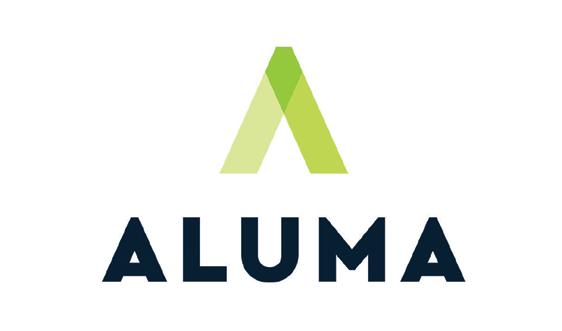









With new credentialing technology in place for gameday staff, media and others, the NFL has activated what one stadium official calls an ‘onion of security.’
By Michael Popke
WHEN CATHY LANIER WAS NAMED CHIEF SECURITY OFFICER of the National Football League in 2016, one of her top priorities was to implement an internal credentialing system to streamline and secure entry for thousands of gameday team and stadium staff, media members and others.
“I came from an environment where credentialing is one of the most key components of security,” says Lanier, who worked for more than 26 years at the Metropolitan Police Department of the District of Columbia, where she oversaw planning for such high-profile events as presidential inaugurations and State of the Union addresses. “You can have a secure perimeter, but if you don’t have credentialing as part of that security solution, that allows people once inside your hard perimeter to go anywhere they want, whenever they want. And we have some very sensitive areas, obviously. Some people only need certain access at certain times in certain places. So if you only need access for a short period before kickoff, I’m not going to give you blanket field access.”
You can have a secure perimeter, but if you don’t have credentialing as part of that security solution, that allows people once inside your hard perimeter to go anywhere they want, whenever they want.
CATHY LANIER National Football League
After years of researching best practices and vetting technologies, the league introduced an opt-in credentialing system anchored by facial authentication technology for all 32 teams at 30 NFL stadiums in 2024. That followed a pilot program in 2023, when a half-dozen teams focused on limited access to such key areas as the field, service level, locker rooms and media spaces.
“As we moved through the pilot season, we rolled it out to more and more people,” says JP Hayslip, vice president of facility security for the Philadelphia Eagles.
“By the end of that season, we had pretty much all of our fulltime staff on it. We requested feedback on what worked and what didn’t work, and also got feedback from our event security partner.”
Feedback from the Eagles and the other five pilot teams helped Lanier and her staff ultimately deliver a system in which all individuals requiring credentials register with Accredit Systems, a UKbased centralized software platform. Accredit, in turn, interfaces with multiple hardware and software systems in place at stadiums — including Wicket facial authentication software, Zebra Identity Guardian multifactor authentication support, and other access-control scanning technology from FortressGB and Alvarado. A green light means an individual has legitimate access, while a red light sends up a warning flag.

stadiums,” Lanier says. “One that could prove who you say you are, because fraudulent credentials are a big problem, and one that had the flexibility that we needed that were very specific to people, time and place. The driver for me was closing a hole in the fence. I didn’t have 100% secure accreditation that was foolproof.”
Already, the impact can measured by higher security audit scores at stadiums, thanks to tighter access.
“This allows security guards to actually have something to back them up, to say, ‘No, it’s red. I cannot allow you in here.’ They are now more confident at their locations,” says Sam Cornejo, senior director of security and guest experience at State Farm Stadium in Glendale, Ariz., which is operated by ASM Global and is home of the Arizona Cardinals — another one of the 2023 pilot teams. “In the past, that person could have tried to negotiate a way to get through.”
Stadiums and teams have implemented multiple identification verification procedures that involve biometric authentication and QR codes (depending on the credentialed individuals and locations involved).
“I needed a system that would meet the demands we have, in literally hundreds of zones across all the
“Let’s go back to a non-pilot, non-credentialing-technology gameday,” Cornejo says. “Were too many credentials given out? A credential may have said ‘locker room’ or ‘press’ or ‘field.’ But now, with this true onion of security, credentials are being checked at every level” and only allowing certain access to those who truly have it.
“While there’s a lot of data about the number of scans and other information, that’s not useful in telling me how effective this is. What tells me how effective this is are the users and the staff experience,” says Lanier, adding that the league consistently tracked first-year reactions from all teams throughout the season. “With all that feedback, we now have more accountability. We can now share across the whole enterprise. And if somebody misuses their credential, we can suspend them or revoke them, and they won’t get credentialed anywhere, at any of our stadiums.”
This allows security guards to actually have something to back them up, to say, ‘No, it’s red. I cannot allow you in here.’ They are now more confident at their locations.
SAM CORNEJO State Farm Stadium
Such a massive credentialing overhaul does not come without anxiety, even for the teams and stadiums that volunteered and were chosen to participate in the pilot program and had an extra year of preparation. Thousands of full-time and part-time employees needed to register with Accredit and upload their photos, and each of them required varying degrees of access to specific spaces. Then there was the added expense of purchasing the necessary hardware devices and software technology, followed by training in-house staff members and third-party partners about how to use them.
“Anything new that involves a large number of people will always make you nervous,” says Hayslip, who also is co-chair of the NFL Stadium Security Committee. “Worst case scenario? As soon as we open the gates, everything goes down. Sometimes technology works, and sometimes it doesn’t.” (No system failures were reported.)
The Eagles include a QR code on each Wicket facial authentication device posted throughout Lincoln Financial Field. This allows a security team member to scan it and contact a command post to request assistance if the technology glitches or denies access to a credentialed person — or if another issue occurs.

Don’t miss a general
Monday, June 30 1:25-2:10 p.m. Cibolo 5-7
“We don’t want our security staff to be trying to handle each situation,” Hayslip says. “That kind of internal communication was very beneficial for us.”

Prior to the start of the 2024 NFL season, Cornejo says his staff and the Cardinals did a walkthrough of State Farm Stadium to identify areas of entry for all personnel, as if it were an actual gameday.
“We asked, ‘Where is everybody entering from? Where are the areas where people need to be scanned in?’ That’s how we determined how many units we needed of each technology — and where,” he says, adding that based on real gameday scenarios during the pilot season, the stadium expanded its inventory of Zebra and Wicket units for 2024.
All scheduled workers and other credentialed individuals for a given gameday are activated for access via Accredit.
“You, as a member of the media, would come in through the main concourse outside of our building,” Cornejo says. “We would scan you in with the Zebra unit, which allows you inside. Once you go to the press level, you would be met by a Wicket unit. You should be getting a green light at those locations. What we’re doing is giving our security people an extra tool to make their jobs easier, and it’s really cleaned up specific areas where there used to be heavy traffic. Now, if staff needs access to locker room spaces, they don’t go through a hallway as a shortcut. Areas are limited only to folks who need access to them.”
‘WE’RE
Team officials and stadium operators provided regular updates to the NFL about how the new system was working throughout the season. But league leaders also heard from online privacy groups that called for the removal of facial authentication in its new credentialing process.
As Gameday Security reported in the Summer 2023 issue, the term “facial authentication” has become erroneously synonymous with the term “facial recognition” — even though there are critical differences between the two technologies.
“Facial authentication is a 1:1 (one-to-one) mechanism,” according to Wicket’s website. “This … works to exclusively match the face in the camera feed to a previously provided image from a user of the authentication tech. Not only does this protect individual user privacy by requiring opt-in, but the format reduces the risk of false positives and false negatives by nature — since the source image has to be a high-quality, clearly visible image of the user.”

Once word gets out that this is working, I do believe other leagues will implement something probably very similar.
JP HAYSLIP Philadelphia Eagles
Facial recognition, on the other hand, uses a one-to-many mechanism that compares and matches a single face in a crowd to a human face that has been previously provided. As Wicket notes, it “uses a camera to run an image through a large database of faces to look out for” and can be used for surveillance and security purposes, such as finding individuals in a crowd.
“We did two years of research, and we were very careful,” Lanier says. “The first thing I did was bring in good privacy attorneys. There’s nothing I’m going to do, especially with technology, that’s not going to go through them first. It’s important to remember that this is an opt-in system with facial authentication — not facial recognition — and I think people understand that. If you want to come work in our stadiums and be part of the team, we have requirements to meet for security reasons.”
Less than a half-dozen people expressed concerns about the new process, she adds, and some of them changed their minds once they better understood how the technology works.
As Hayslip puts it: “We’re not going to give your face to the FBI.”
Meanwhile, the NFL’s credentialing technology has the potential to work for other leagues, too.
“I think what we were able to do here is something that, no matter what your business is — if you need a real secure way of identifying who has access to what and when, and you need 100% validation of who those people are, that they are who they say they are — you’re going to need to make the investment,” Lanier says. “Some of the technologies we decided to go with were on the horizon; they were not yet mainstream. But we were trying to push the envelope, because we knew the technologies had become much more sound.”
“Once word gets out that this is working, I do believe other leagues will implement something probably very similar,” Hayslip adds. We’re all trying to achieve the same thing, and that’s the safety of our guests, the safety of the players, the safety of the staff. This is an educational process, and I always say that when it comes to security, you’ve gotta be right every time.” l

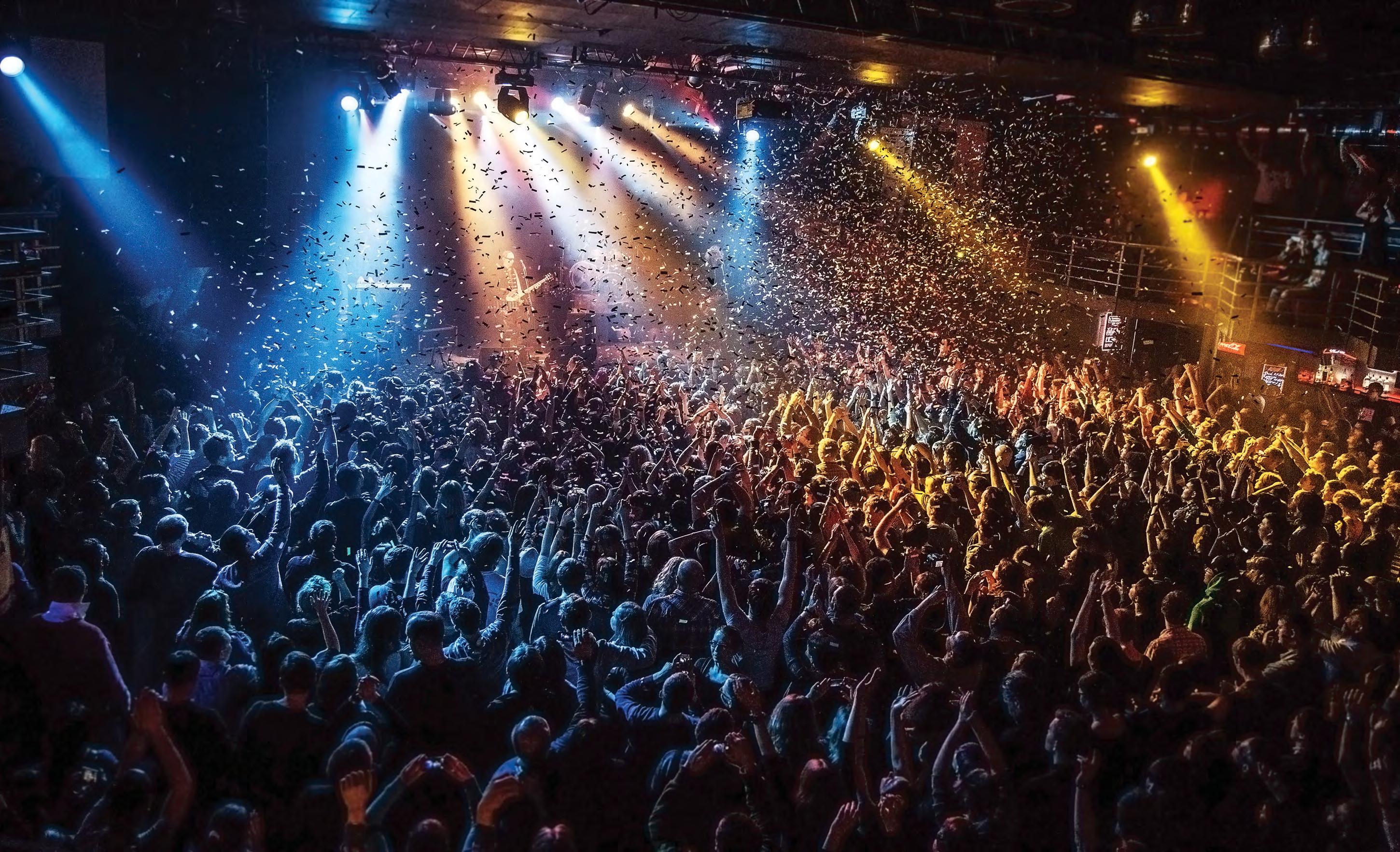








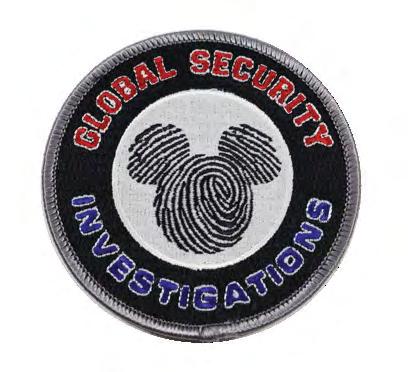




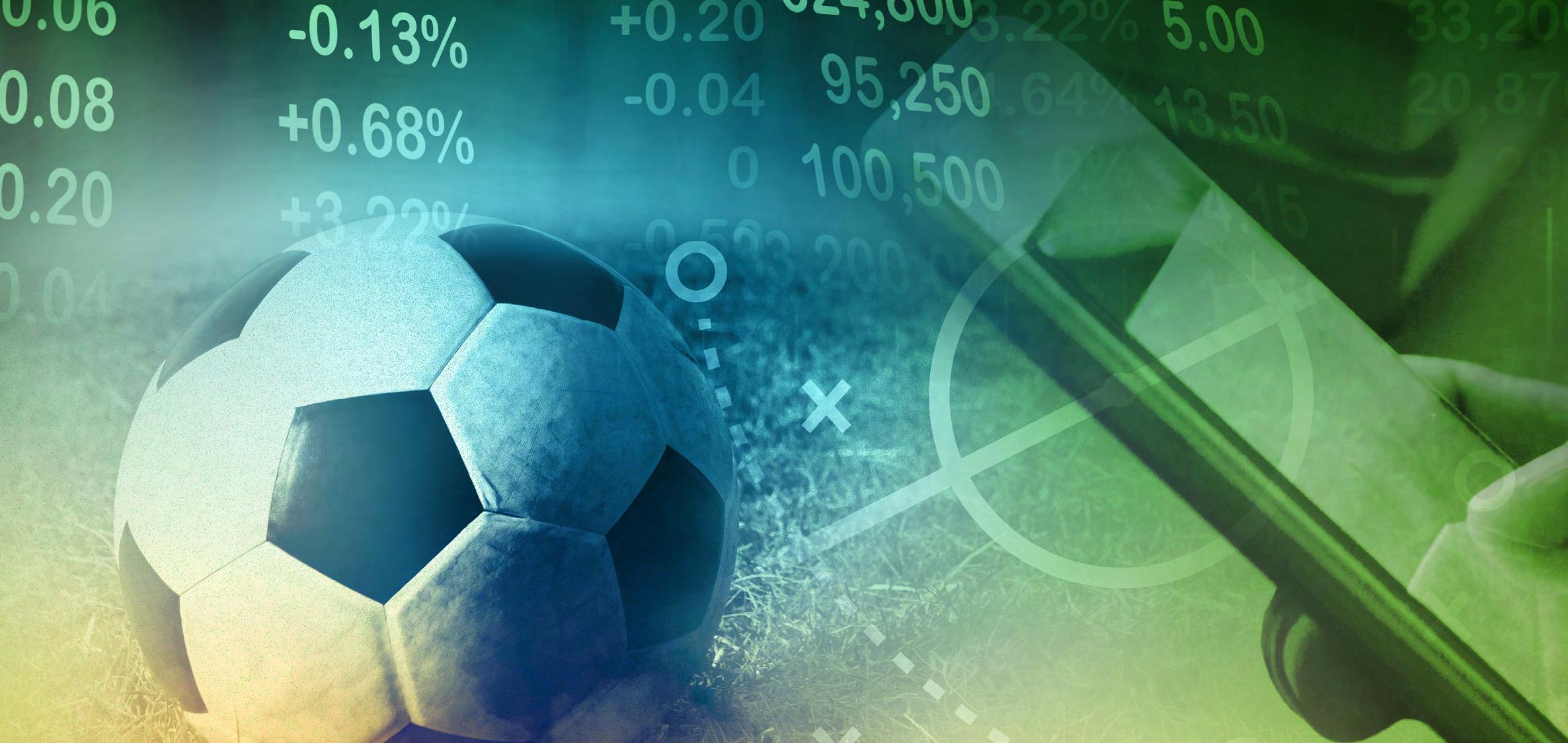
As more people participate in legalized sports betting — and the stakes get higher — online harassment of athletes is escalating. Here’s what you can do.
By Michael Popke
LAST FALL, THE NCAA RELEASED AN ALARMING ANALYSIS of online harassment in college sports. The report — which includes a front-page warning label alerting readers to “explicit examples of discriminatory, violent and threatening content” — indicated that 12% of all social media abuse of student-athletes, coaches and officials taking place during championships in several sports was related to sports betting. Only online abuse of a sexual nature was more prevalent (18%).
The association partnered with London-based data science company Signify Group (and the firm’s Threat Matrix service, powered by artificial intelligence) to monitor public comments targeting the online profiles of participants in seven Division I NCAA championships and the College Football Playoff National Championship across 2023 and 2024.
What you see is really dramatic and abusive language, a lot of which is directed at women.
Homophobic,
misogynistic stuff. The report confirmed our suspicions that this is a real problem.
MARK HICKS NCAA
Signify Group’s analysts reviewed more than 72,000 messages that were flagged by the AI-based algorithm from a wider dataset of 1.3 million posts/comments targeted at the social media profiles of student-athletes, coaches and officials taking part in the events. From the messages analyzed, Signify’s team verified more than 5,000 posts contained abusive, discriminatory or threatening content.
There were more than 740 instances of abuse related to sports betting, based on the exact language within the posts. Here’s an example: “Yo no big deal but if you don’t get 22 points and 12 boards everyone you know and love will Be dead[.]”
However, deeper analysis suggested that much of the abuse in other categories (such as sexual and racial
content) was influenced by sports-betting behaviors. This created overlapping abuse primarily targeting student-athletes and officials.
“What you see is really dramatic and abusive language, a lot of which is directed at women. Homophobic, misogynistic stuff,” says Mark Hicks, managing director of enforcement for the NCAA. “The report confirmed our suspicions that this is a real problem.”
Over time, we’ve seen the language of the threats increase to a point where law enforcement may need to get involved. And unfortunately, it’s an upward trend.
TODD SANDSTEDT
Since the United States Supreme Court in 2018 struck down a 1992 federal law prohibiting sports gambling, at least 39 states and the District of Columbia have legalized sports betting. That has led to a financial windfall for states in the form of more tax revenue, but it also has emboldened bettors.
“I guess it’s somewhat understandable in this new age of being able to reach out and touch people via social media,” says Todd Sandstedt, a former FBI special agent and now managing director of SecureSport, a Colorado-based consulting firm that works with professional and collegiate sports teams on a variety of security issues. “As people start to lose money as part of their wagering activities, there is a small percentage taking out their frustrations and their anger on student-athletes as a result of their losses and holding them accountable.”

Sandstedt says the online abuse — commonly via direct messaging on social media apps — can range from “You messed me up. I had a bunch of money on this game. How dare you?” to ones much more vile and threatening, as detailed in the NCAA/Signify report
“Over time, we’ve seen the language of the threats increase to a point where law enforcement may need to get involved,” he says. “And unfortunately, it’s an upward trend.”
And it’s happening not only at the collegiate level but also with professional athletes and even Olympians.
The New York Times’ Athletic.com polled 161 National Hockey League players last fall, asking “Do you get more harassing messages from fans since sports betting was legalized?” One-third of the 157 respondents answered “yes.”
“Oh, almost every day,” one goaltender told TheAthletic.com. “Honestly, I’d say 75 percent of them are them being mad about something. ‘How did you let in that late goal? I had the under. Thanks a lot. You f—ing suck.’ Things like that constantly.”
There are Venmo payment requests, too. “They’re demands, not requests,” one player clarified. “‘You owe me $200 because you were on the ice when …’ and it’s insane.”
Olympic athletes endure online abuse, too, with basketball, soccer and tennis ranking among the most popular sports for bettors, says Nicole Deal, chief of security and athlete services for the United States Olympic & Paralympic Committee. The International Olympic Committee identified more than 3,000 instances of online abuse during the 2024 Summer Games in Paris, with a significant increase in threats toward female athletes.
“When it comes to harassment for Team USA athletes, we can’t make a direct correlation to betting,” Deal says. “There are general threats of, ‘Someone should break your knees,’ or racial or misogynistic threats, a lot of hate language.”
She calls such threats “a mental health issue and an athlete wellbeing issue, more than a betting integrity issue.”
Which is why entities from sports organizations to state legislatures have made curbing online abuse related to legalized sports betting a top priority.
“My concern is that we already were seeing a volume of this activity, but now we have more states where sports betting has been legalized and more people who are involved in it,” Sandstedt says. “Just doing simple math, the percentages of this activity are likely to grow, and we certainly don’t want it spilling over into any type of in-person confrontation.”
In 2024, Americans spent almost $150 billion on sports betting, according to the American Gaming Association — a 25% increase over the previous year. Additionally, TIME reports that state governments collected about $2.5 billion in sports-betting tax revenue — a 19% increase from 2023.
States regulate sports betting differently. And regulators, Sandstedt says, didn’t necessarily foresee some of the challenges that have evolved — such as online abuse of athletes by bettors.
“The regulators want to be part of the solution,” he says. “I deal with these folks a lot, and they’re really talented. Now they’re getting an idea of what legalized sports betting looks like, both the good and the things they should be concerned about. A lot of these regulatory agencies also have a law enforcement arm. So that helps, too.”
Last year, lawmakers in a handful of states took matters into their own hands by passing harassment-related bills. West Virginia and Ohio were among the first to put specific rules in place allowing state betting commissions to ban sports bettors who harass athletes. In November, the Wyoming Gaming Commission followed suit, amending that state’s sports betting regulations to define harassment to include “verbal threats, written threats, electronic threats, lewd or obscene statements or images” and more.
Don’t miss a general session on:
Tuesday, July 1 9:30-10:15 a.m.
Cibolo 5-7

Sandstedt recommends security professionals form positive relationships with gaming regulators in their state and encourage them to apply penalties to bettors who harass.
“The regulators I’ve worked with and gotten to know are pretty open to this idea of working with professional and collegiate sports teams to have a good, open dialogue about how things can move forward,” he says.
“The NCAA is very active on a number of fronts when it comes to legislative changes. We would like to see states eliminate performance-based prop bets on student-athletes,” Hicks says, referring to side wagers such as who will be the first player to score a touchdown in a given game. “We feel like it puts a target on the back of a young person when a specific bet is tied to their individual statistical performance. That just sets the student-athlete up for harassment, right?”
He notes that at least four states (Louisiana, Maryland, Ohio and Vermont) have banned individual studentathlete proposition bets, and NCAA efforts have been successful in banning college prop bets in 18 states and Washington, D.C. Two additional states (New Jersey and New Mexico) also have introduced antiharassment legislation related to sports betting.

“The other thing we have been very aggressive in advocating for is addressing harassers,” Hicks continues, citing the steps taken in Ohio, West Virginia and Wyoming as “a great start.” “I think it’s one measure of many that help combat harassment. Awareness of what’s happening at the local level, the law enforcement piece, the legislative policy piece — all of those working in unison are what’s going to help us turn back the harassing behavior. I don’t think any of those in isolation is going to solve the problem.”
As state regulators, legislators and other entities strive to work in unison, the ongoing mental wellbeing of athletes is emerging as a top concern.
“The increased social media profile of athletes, and of people being able to reach out to someone, has created a very different landscape,” Deal says. “Then, add betting on top of that, and it changes the threat environment.”
An athlete’s mental health is treated like another layer of security protection for members of Team USA. Roughly half of the sports medicine cadre that accompanies athletes to Olympic competition are mental health providers, according to Deal, who adds that athletes are encouraged to report online harassment and talk about it with their coaches and mental health specialists.
The USOPC also works directly with social media platforms to remove offending content.
“Some are really easy to work with, and with others it takes a little bit more time,” says Holly Shick, chief ethics and compliance officer for the USOPC. “We explain the toll that it’s taking on a person, remind
It’s a mental health issue and an athlete wellbeing issue, more than a betting integrity issue.
NICOLE DEAL
United States Olympic & Paralympic Committee
them that it violates their community guidelines and help them understand the mental health side. We might actually be able to take [the harassing message] down before an athlete even sees it, if it’s not a personal DM.”
Hicks at the NCAA says its partner Signify engages with social media companies in a similar manner. One of the challenges, though, is convincing studentathletes to even report online harassment in the first place. Some might prefer to ignore it, or tell a friend or loved one but not a coach or administrator.
“We encourage schools to educate and have a dialogue with their student-athletes around harassment, to make sure they have a clear understanding of what they should do and where they should go if they’re receiving harmful messages,” Hicks says. “When we get notice of a potentially threatening situation, we call law enforcement.”
Working collectively to curtail online harassment is vital, he adds.
“There is now awareness of an issue I think people knew was there but had a hard time getting their hands around,” Hicks says. “Each school needs to have its own way of creating resources and support for student-athletes and coaches around this issue.”
“We’re having these conversations, and that makes me happy,” Deal adds. “Other people are having this conversation, too, and are aware of the impact that online abuse has on individuals — both as athletes and as people. The thing that concerns and saddens me is that this is just not a sports challenge. We’re connecting it to betting, but this happens in the real world outside of sports, too. So until there can be a real-world solution, it will always be a problem.” l

Applying for SAFETY Act designation and certification status requires a major commitment from venue operators, but the return on investment can be significant.
By Michael Popke
RON LITTLE KNOWS A LOT ABOUT THE SAFETY ACT. As director of security for Lumen Field in Seattle — home of the National Football League’s Seahawks, Major League Soccer’s Sounders and the National Women’s Soccer League’s Reign FC — he oversaw the 2018 awarding of that facility’s SAFETY Act Designation and Certification, the highest level of security accreditation given by the U.S. Department of Homeland Security. Lumen Field was the first sports and entertainment stadium on the West Coast (and among the first in the entire NFL) to achieve that distinction. Little also took the lead in renewing the venue’s SAFETY Act designation and certification renewal in 2023.
Now, as vice president of security at Crypto.com Arena in Los Angeles, he’s striving to attain that same level of SAFETY Act recognition.
When you’re applying for the SAFETY Act, it is the one time you have to brag about what you have done for your facility — the processes and policies that you’ve put in place to make it a safer place.
RON LITTLE
“For me, as a security professional, this is a matter of pride,” Little says. “When you’re applying for the SAFETY Act, it is the one time you have to brag about what you have done for your facility — the processes and policies that you’ve put in place to make it a safer place.”
An acronym for “Support Anti-Terrorism by Fostering Effective Technologies,” the SAFETY Act was included as part of the Homeland Security Act of 2002 to highlight an organization’s ability to manage risks associated with terrorism and other high-threat scenarios. Status can be renewed every five years.
Though created in the wake of 9/11, the act also encompasses “non-terror risks and perils,” says Robert Benvenuto, Chicagobased regional chief growth officer and a member of the Midwest executive management team for HUB International Ltd., a leading North American insurance brokerage that
works with organizations that have achieved SAFETY Act designation and/or certification. Such threats can include explosions and fires, an active shooter, a drunk driver, a vehicle rammer and more.
Additionally, the SAFETY Act provides a framework for organizations to enhance their security practices by guiding the selection and application of technology, procedures and personnel for comprehensive risk management. The intention is to lead to more efficient systems, better preparedness and improved response capabilities during potential incidents, according to Daniel L. Ward, former director of training and exercise at the National Center for Spectator Sports Safety and Security (NCS4).
“The SAFETY Act identifies best practices, the things you should be doing,” says Akmal Ali, founder and chief executive officer of the Washington, D.C.-based risk management and security consulting firm Aluma, who is assisting with Crypto.com Arena’s SAFETY Act application and also helped Lumen Field achieve its designation and certification. Before founding Aluma, Ali was deputy director of the SAFETY Act program at DHS, expanding its scope. “The whole point is, how do we motivate the private sector to push the envelope in the fight against terrorism at their venues by running a risk assessment and taking a chance on deploying emerging technologies — like frictionless screening — when doing so might actually expose them to more liability?”
“designed for those eligible technologies, products and security programs that have a proven track record of effectiveness in the field. The Designation provides a numerical cap on third-party liability arising from an act of terrorism.”
“Certification,” on the other hand, is “designed for companies [that] demonstrate a long-term effectiveness and a plan to ensure it will continue to be effective over time. The Certification provides an awarded company the liability to assert Government Contractor Defense that immunizes the awarded company from third-party liability arising from an act of terrorism. This level of coverage requires significant deployment data over time.”
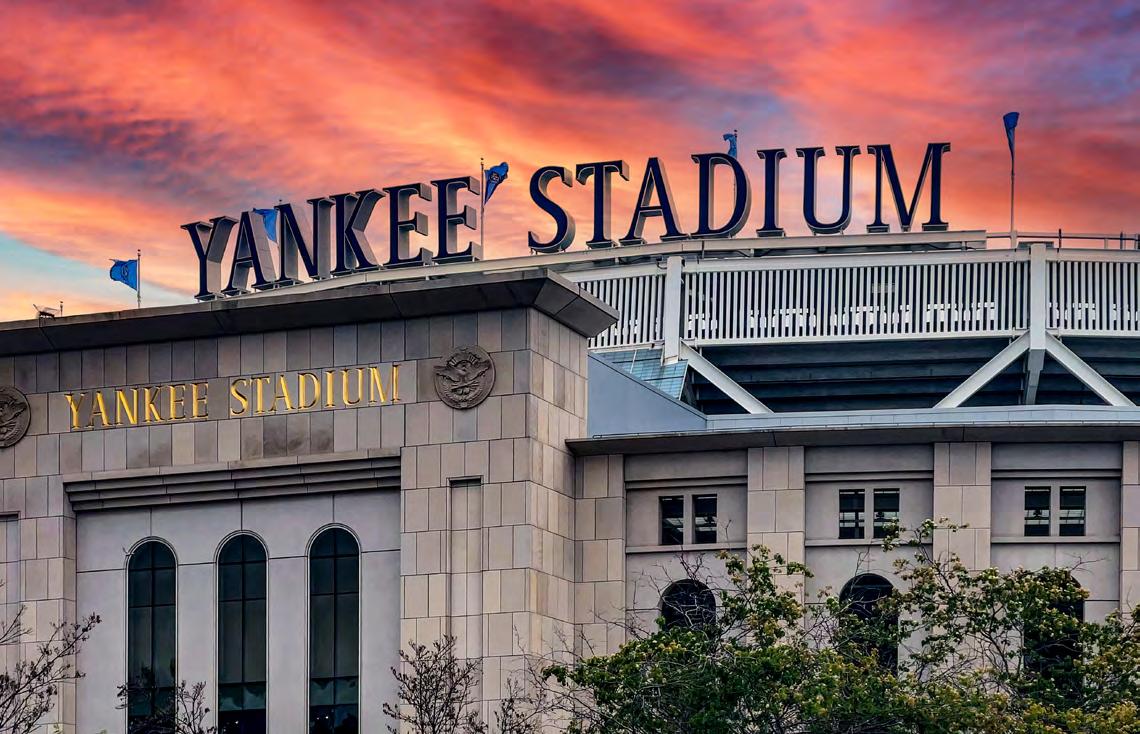
Lumen Field did not have to pursue both designation and certification status at the same time, nor does Crypto.com Arena. But doing so can help reinforce already effective security measures.
“I know what DHS is looking for, and I also know how to protect my facility,” says Little, who arrived at Crytpo.com Arena in January 2024. “So the policies and processes that I have built, written and implemented are strong enough to achieve both.”
As of early 2025, dozens of stadiums, arenas and ballparks affiliated with professional sports teams had achieved at least one level of SAFETY Act recognition, according to Ali. (Few collegiate venues have followed suit.)
There actually are three levels of recognition. The two most common are “Designation” and “Certification.” As noted on Aluma’s website, “Designation” status is
Additionally, the “Developmental Testing and Evaluation Designation (DTED) is a subset of the designation level and “designed for those eligible technologies, products and security programs that have demonstrated effectiveness in controlled environments but lack real-world deployment data,” according to Aluma’s website. “[DTED] provides a numerical cap on third-party liability arising from an act of terrorism with specific restrictions in place.”
Attaining any level of SAFETY Act recognition involves a thorough assessment process that is time-consuming, complicated and costly.
“The process is a complete dissection of your security program,” Little says. “It includes explaining the physical security that protects your exterior, identifying your policies and procedures for every aspect of your program, background checks and physical screenings,
The whole point of the SAFETY Act is, how do we motivate the private sector to push the envelope in the fight against terrorism at their venues — when doing so might actually expose them to more liability?
how you train, and how you test your team to ensure that your policies can stand up to any incident. Documentation is a key focus moving forward.”
Ali notes that a typical SAFETY Act application for designation or certification status is more than 300 pages long, with thousands of pages in attachments, and the approval process can take a year or more. That’s why many organizations retain consultants like Ali to help their security teams pursue designation and/or certification. Primary initial expenses include paying for that outside guidance and then implementing strategies needed to meet SAFETY Act criteria.

EDITORIAL
CREDIT: COLINMTHOMPSON / SHUTTERSTOCK.COM
“So if I meet with you, and you’re not doing red team assessments, one of my recommendations is going to be to put in a red team assessment program, which is going to cost X amount of money per year,” Ali says.
The long-term benefits that stem from attaining SAFETY Act status, however, significantly outweigh the initial investment of time and resources, Ward says. Examples of return on the initial investment can include but are not limited to the following:
• Reduced liability and insurance costs: Organizations with SAFETY Act certification may experience reduced liability exposure and lower insurance premiums as insurers recognize the organization’s ability to mitigate and manage risks effectively. This can lead to substantial cost savings over time.
• More government contracts and grants: Many federal and state contracts and grant opportunities prioritize or require SAFETY Act certification. The designation can improve an organization’s chances of securing such opportunities, thus generating increased revenue and business growth.
• Greater operational efficiency: The rigorous process required to achieve SAFETY Act designation often results in implementing best risk management and security practices.
• Increased reputation and trust: The SAFETY Act serves as a recognized symbol of excellence in security. Organizations with this certification enhance their credibility with clients and regulatory bodies.
To that last point, positive press and enhanced public perception can go a long way, notes Brian Finch, a partner at the law firm Pillsbury Winthrop Shaw Pittman in Washington, D.C., who helps clients navigate the SAFETY Act’s application process.
“It depends on the individual team and how they want to talk about their SAFETY Act protections and operations, but it certainly could be a good move to assure fans that the policies and procedures in place are solid and have been independently vetted by a government agency,” he says. “They’re able to say to the fans, ‘Hey, we run a place that’s pretty darn secure.’”
Once an organization has achieved SAFETY Act status, it makes sense that its insurance premiums would be lower, Ali contends. But historically, that has not been the case.
“The most elusive thing for us has been getting insurance underwriters to understand [the act],” he says. “Why aren’t organizations getting more insurance breaks on premiums if they have SAFETY Act status? Well, we found out that it’s not the brokers who do the pricing; that’s the underwriters’ job. They’re the ones saying, ‘Hey, you know what, Stadium? I’m going to evaluate your security program and offer you this amount of insurance for this amount of money per year, because that is how risky I think you are.’ Well, if they really understand how much goes into the SAFETY Act, they would realize that — holy cow — this process is very rigorous and in-depth. It’s like the world’s best underwriting process that you could ever experience.”
Benvenuto agrees, and he’s worked with Ali to help his fellow underwriters gain a stronger handle on what the act means for their clients. Ideally, that should lead to favorable insurance policy changes for organizations. But just as security teams must work persistently to apply for and retain SAFETY Act designation and certification, they also need to continually advocate for themselves and their venues.
If you’re not going to pursue this, you better have a really good reason as to why. In today’s world, having a safe harbor to limit your liability and keep your insurance intact is pretty rare.
BRIAN FINCH Pillsbury Winthrop Shaw Pittman
“If you have gone through the process to obtain SAFETY Act status, make sure that when presenting the risk profile to the insurance underwriting community you share all of the things you’ve been doing to improve that risk profile in order to maintain SAFETY Act status,” Benvenuto says. “Use that as a negotiating tactic to get better terms and conditions and pricings from the insurance marketplace. The onus is on you.”
“[The act] has tangible and intangible impacts,” Finch adds. “The intangible is this assurance of liability sitting in your back pocket in case a terrible event occurs. The tangible is that, if you do it right, you can realize savings on your insurance premiums that more than pay for the safety and protection application costs. It’s very individualized, but we’ve certainly had more than a few applicants report back to us that they actually, quote-unquote, made money by pursuing the SAFETY Act because it resulted in a pretty significant reduction in their insurance premiums.”
If you have gone through the process to obtain SAFETY Act status, use that as a negotiating tactic to get better terms and conditions and pricings from the insurance marketplace. The onus is on you.
ROBERT BENVENUTO Hub International Ltd.
The SAFETY Act’s evolution can be seen in other areas, too. Over the past decade or so, it has become more rigorous as more entities gain a stronger grasp on how it works, what organizations it applies to, how it applies to new threats such as drones, and how it relates to cybersecurity issues rather than simply physical security issues.
“If you’re not going to pursue this, you better have a really good reason as to why,” Finch concludes. “In today’s world, having a safe harbor like this to limit your liability and keep your insurance intact is pretty rare.” l
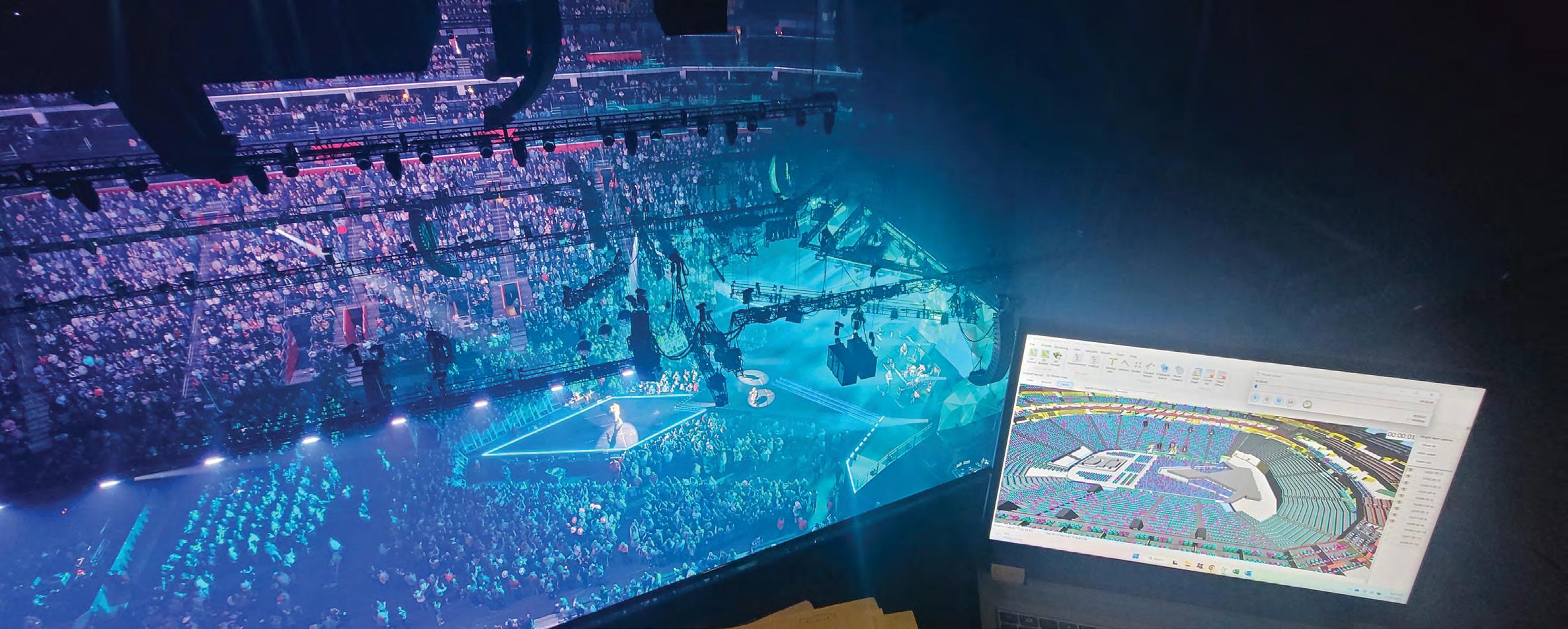
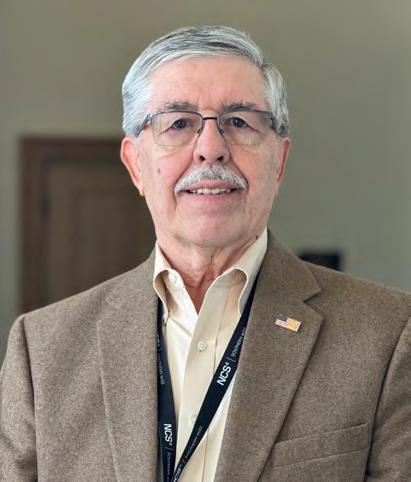
BY GARY L. GARDNER VP, InControl Simulations, North America; FBI (Ret.); former NASCAR Director of Security; and NCS4 National Advisory Board Member
1. It begins with how people arrive: car (think parking), bus, rail, rideshare, and their pathways to the venue.
2. Next is entry, queuing, screening, and ticket scanning.
3. Once guests are in the venue, they will circulate and enjoy concessions, advertising activations, and merchandise sales.
4. Some incidents during the event may require evacuation or sheltering.
5. Finally, ensuring a smooth departure to a transportation mode.
Simulation is a powerful tool for event crowd management because it can model, analyze, and predict/anticipate crowd behaviors in a safe, controlled, and cost-effective manner.
The goal is to leverage the best technologies coupled with the best human team to provide the best experience.
Simulation digital twin modeling has evolved from one-off ingress, evacuation, and sheltering models of a venue using historical data for predictive analytics to simulating each event using real-time data integration to protect and enhance the event experience. Advantages of utilizing simulation in sport and entertainment safety and security planning:
• Simulations allow event planners to test scenarios without putting attendees at risk for any type of incident. Each event is different and should be simulated.
• Potential hazards, such as overcrowding/crushing, bottlenecks, or evacuation/sheltering challenges, can be identified and mitigated before the event occurs.
71% of fans report insufficient response to incidents they have witnessed.
10-15% of revenue comes from merchandise sales, but 60% of guests skip the lines because of their length. 5 4 3 2
• Using simulation software, planners can analyze various data points, such as expected crowd size, venue layout, densities, bottlenecks, and movement patterns for people and traffic.
• Dynamic data integration from ticketing, scanning, GPS, cameras, sensors, and point of sale allows you to monitor behaviors as they happen, making real-time decisions and continuous improvement.
• These insights enable informed decisions about resource allocation, staff deployment, activations, and infrastructure design, enabling quick adjustments to manage congestion or address safety concerns.
• Simulations help determine the most efficient use of space within and outside a venue, including entrances, exits, seating arrangements, activations, pathways, tailgating, transportation, parking, and signage.
• Modern events have more complex floor plans than ever before. Each unique layout puts different stresses on staffing resources. Simulation is a tool for both safety and staffing efficiency.
• It can highlight areas prone to congestion and suggest adjustments to improve pedestrian and traffic flow.
• Tested and validated crowd dynamics simulation models can predict how crowds will respond to different situations, such as emergencies or delays of various demographics.
• This foresight allows for the development of robust emergency response plans, reducing the risk of accidents and ensuring rapid evacuation/sheltering when necessary.
• Establish early warning systems by detecting unusual patterns, such as sudden crowd surges. Digital twins can alert organizers to potential hazards before they escalate.
• Testing different layouts, optimal staffing levels, and event schedules in a virtual digital twin environment is far more cost-effective than making real-world adjustments during or after an event.
• Revenue generation can be enhanced using simulations to optimize activation/concession placement, reduce queuing time, and improve customer experience.
Fans spend an average of 42 minutes waiting in lines when attending major events.
Fans say they would spend $20 more on food or beverage if line times were cut in half.
Weather related shelters and evacuations have increased 62% over the last 10 years. 6
• Simulations can model a wide range of “what-if” scenarios, such as extreme weather, unexpected surges in attendance, or security incidents, such as active shooter or bombings.
• Virtual environments allow staff to practice handling different scenarios, improving preparedness and coordination.
• Minimize waiting times by optimizing crowd movement and reducing bottlenecks. Simulations contribute to a smoother, more enjoyable experience for attendees through more effective circulation and queuing.
• They can also aid in the placement of amenities like food stalls, restrooms, and information booths for maximum convenience, which enhances revenue.
• Slow service or even the perception is a deterrent to sales of more food and beverage; it also prevents some from even approaching concessions. Fixing this means direct rewards for venue operators.
• Personalized experiences with simulation can incorporate attendee preferences (e.g., preferred seating or faster access routes, reduced queuing) to design more user-friendly layouts.
• Digital twin simulations provide evidence that safety standards and legal requirements/ accountability have been met, simplifying the approval process for permits, such as safe capacities for Fire Marshal approval.
• Facilitates the Department of Homeland Security (DHS) SAFETY Act certification planning and approval process (see dhs.gov).
• They offer detailed records and audit trails of crowd management efforts, which can be helpful for post-event evaluations or liability inquiries. This is particularly important for obtaining permits, ensuring legal accountability, and reducing liability.
• After an event, simulation tools can analyze crowd and camera data to identify areas for improvement in future events for both people and traffic.
• This continuous feedback loop enhances the long-term effectiveness of crowd management strategies.
• Eco-friendly planning by testing virtual layouts allows organizers to reduce the need for physical trials, cutting down on resource consumption, waste, and staff.
• Energy Efficiency simulations help optimize power usage by planning the location, timing, and operation of equipment like lighting and HVAC systems.
• Event staff, security staff, and first responders can use simulations to practice their roles in different scenarios, thereby improving readiness, coordination, and response.


“Using simulation software was an intricate part of our SAFETY Act
Certification preparation and application by demonstrating our ability to develop effective safety/security plans.”
RICHARD FENTON
CSSP, Vice President/CSO, Corporate Security and Safety, Ilitch Holdings Inc., and NCS4 National Advisory Board Member


Digital twin simulation modeling revolutionizes event crowd management by offering significant benefits by combining data for real-time insights, predictive analytics, and scenario testing into a single, cost-effective, powerful platform. It enhances safety, efficiency, revenue, and the overall attendee experience while providing a robust tool for pre-event planning and on-the-spot decision-making, allowing for the mitigation of potential incidents/risks and enhancing the capability to respond effectively to incidents. Today’s sports fans want more than just a game—they want a memorable and safe experience, and with simulation, you can provide that future experience today.




SPORT AND SPECIAL EVENT RISK MANAGEMENT AND PLANNING AWR-167
Building capabilities for multi-agency collaboration, intact teams are immersed in a collaborative environment incorporating basic concepts relative to planning, risk assessment, training, exercising plans, and recovery/ business continuity through scenario-based training modules.
SPORT AND SPECIAL EVENT STAFF TRAINING AND DEVELOPMENT MGT-304
This DHS/FEMA-funded course brings together first responders, government, and commercial facilities personnel to improve safety and security training and development programs. The overall goal for this training is to provide tools and methodologies for training and developing staff assigned to and responsible for public safety at sporting and special events.
SPORTS AND SPECIAL EVENTS INCIDENT MANAGEMENT MGT-404
Develops athletic department staffs, facility management personnel, campus public safety personnel, emergency response supervisors, and others involved in sports and special event management to better prepare for, manage, and recover from incidents that could occur during a sporting event or other special event.
SPORT VENUE EVACUATION AND PROTECTIVE ACTIONS MGT-412
Prepares venue operators, first responders, emergency managers, law enforcement, contractors, promoters, and owners to effectively collaborate on evacuation and protective action decision-making. The course provides flexible and scalable protective measures for planning, evacuation, and sheltering.
ENHANCED SPORTS AND SPECIAL EVENTS INCIDENT MANAGEMENT MGT-440
Prepares emergency responders, as well as event management personnel, concessionaires, athletic department personnel, and chief executives who would be involved in the preparation for and response to a large-scale incident during sporting or special events.
SPORT AND SPECIAL EVENT ENHANCED RISK MANAGEMENT AND ASSESSMENT MGT-466
Provides participants with tools and methodologies for conducting venue and event-specific risk assessments. In this course, participants will analyze risk and utilize assessment outputs to determine risk mitigation options and their effectiveness.
SPORT AND SPECIAL EVENT PUBLIC INFORMATION AND EMERGENCY NOTIFICATION MGT-467
Prepares participants to identify and navigate the sport and special event communication landscape before, during, and after an incident. This interdisciplinary course brings planners, operators, communication, government, public safety, marketing, and public relations professionals together to prepare and/or enhance venue and event communication programs.
CROWD MANAGEMENT FOR SPORT AND SPECIAL EVENTS MGT-475
Introduces public safety officials, venue operators, event planners, and community stakeholders to key concepts and considerations for crowd management, control, and dynamics. The course content is scalable and applicable to all sports and special events regardless of venue size, capacity, or type of event.





The NCS4 is the only organization that offers a certification recognizing expertise in sport security management. Earning the Certified Sport Security Professional (CSSP) designation sets you apart from other professionals and highlights your dedication to remaining current with industry trends. Professionals in the sports security industry need to have a firm grasp of public safety measures and understand how to apply those measures in the unique environments created by sports venues and events. The CSSP certification validates expertise in the following domains:
•Business and Facility Management
•Emergency Planning
•Emergency Management
•Legal and Regulatory
•Crowd Management
•Security Principles and Practice
The CSSP certification is awarded to individuals who meet experience, education, and professional reference criteria and pass an exam relevant to sports safety and security management. It is maintained through ongoing continuing education and industry contribution requirements every three years.
•Venue/Event Security Directors/Managers
•Venue/Event Operations Directors/Managers
•Law Enforcement
•Emergency Managers
•Private Security Practitioners
•Fire/HAZMAT
•EMS
•Other Sports Safety and Security Leaders
For more information, contact: CertificationSupport@usm.edu

Scan the QR code or visit the website to learn more.
ncs4.usm.edu/training/cssp
•Expand security knowledge and experience
•Strengthen relationships with peers
•Broaden career opportunities
•Demonstrate a commitment to professional development
• CSSP Application Process
• Senior Leader Course: Sports and Entertainment Security
•See the CSSP Candidate Handbook for eligibility, application, exam preparation, and recertification details.



The 17th annual National Sports Safety and Security Conference & Exhibition will take place June 23-25, 2026, at the JW Marriott Desert Springs Resort & Spa in Palm Desert, California. The conference will offer dynamic programming, solution provider engagement, and opportunities to network with fellow professionals. This highly regarded gathering of sports safety and security professionals is an opportune time to share ideas, tools, and proven strategies to help advance the industry. Please mark your calendar and make plans to join us! Full conference details will be released later this year.
Security directors and operators, facility and stadium managers, event planners/operators, law enforcement personnel, emergency managers, fire/HAZMAT, emergency medical/health services, athletic administrators and governmental representatives
These are individuals representing or supporting: professional sports leagues, intercollegiate athletics, interscholastic athletics, marathon and endurance events, and sport and entertainment facilities (concerts, festivals, e-sports, convention centers, etc.).
• Meet and greet at the opening reception and social in the Exhibit Hall
• Hear from leading industry experts on current topics and technology advancements
• Participate in interactive panel discussions
• Attend the Awards Luncheon
• Network with peers
• Engage with panelists and attendees in dynamic breakout sessions
• Explore emerging technologies
• Discover new products and services in the Exhibit Hall